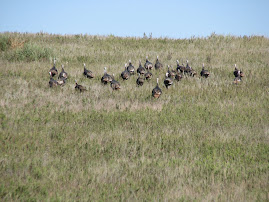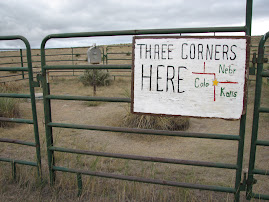One of my new-year goals is to get out and see more of Kansas. So, this past weekend I drove 5 hours to Manhattan to meet up with my grad school officemate and good friend, Lesley. She came to Kansas all the way from Cavalier, North Dakota, which is located in extreme northeast North Dakota, about 15 minutes from the Canada border and 15 minutes from Minnesota. Lesley and I spent about 2 years in the same 10 ft x 10 ft office with 3 other grad students at North Dakota State University in Fargo and she now is an extension agent in Cavalier. We had a great time catching up while exploring Manhattan and the surrounding area.
This was my first trip to Manhattan and I was looking forward to driving by the Konza prairie, located south of Manhattan. There wasn't much to see in January besides dead grass, so I look forward to stopping again when the wildflowers are in full bloom. I loved the landscape though. Lesley commented on how the hills look red from the grass, and I guessed that it was probably little bluestem. The Garden City area is flat land so its nice to see hills and trees, other than salt cedar, once in awhile.
We hiked around the beautiful Sunset Zoo. Our favorite exhibit was probably the flamingos, although the mating snow leopards were a close second! The zoo is set on a hillside facing west and the landscaping was pretty cool. I think I bonded with the 53-yr-old chimpanzee because she was upset when we left. I kind of teared up when I noticed how gnarled and arthritic-looking her hands and feet were. It sucks getting old no matter what species you are.
Next we stopped by the Riley County Museum and the historical Goodnow house which was built in the 1860s. We got a tour of the whole house from a volunteer and it was cool walking through the rooms that were furnished with original furniture and personal belongings. I'm glad we've advanced beyond chamber pots! I would also take my queen-sized mattress over a rope-bed any day. The funniest thing was that one of the museum volunteers has a sister that lives in Denton, NE, which is about 15 miles from my hometown of Crete. *Cue Disney music* It's a small world...
Then on Sunday we went on a driving tour. We checked out the K-State University campus and marveled at the building architecture and pondered the nightmare that must be finding a parking space in the same zip code. Then we drove across the Tuttle Creek Reservoir dam and ended up circling around the entire reservoir as we were cruising the highways. We were both amazed at the extent of tree damage caused by a recent ice storm. It almost looked like a tornado went through the whole county.
Overall it was a great weekend getaway and I was glad to have someone else to bum around with while exploring Manhattan history, culture, and nature.
Sunday, January 13, 2008
Friday, January 11, 2008
About the Sandsage Bison Range...
The Sandsage Bison Range and Wildlife Area is nestled directly south of Garden City. The 3,670 acre area is located west of the (old) Business Hwy 83 just east of the Sunflower Electric Plant. The Bison Range is home of the oldest publicly owned bison herd in Kansas. The FOSBR provide guided tours of the range and bison herd. Check it out on the web (http://www.fosbr.com/).
Brief History: The Bison Range was established in 1916 and the bison were first introduced on the range in October 1924 when one bull and two cows arrived from a refuge in Oklahoma.
Sandsage Prairie description: The Bison Range is one of the few tracts of native sandsage prairie that has not been converted to irrigated cropland. You'll find grasses such as sand bluestem, sand lovegrass, big bluestem, buffalo grass, blue grama, paspalum, and prairie sandreed. You'll find forbs such as sand sagebrush, buffalo gourd, bush morning glory, sand snowball verbena, spiderwort, Devil's claw, and Indian blanket flower. Some of the critters you could see include lesser prairie chicken, kangaroo rat, scaled quail, black-tailed jack rabbit, mule deer, western hognose snake, and ornate box turtle.
Point of Interest: Did you know there was a (planted) national forest in southwest Kansas? Well, for a short time anyway. Prior to becoming the Bison Range in 1916, the land was part of the federally owned and operated Kansas National Forest. By 1915 more than 800,000 seedlings had been planted, but only a few surviving trees remain to this day. As you can guess the project was a failure and the land was turned over to the State of Kansas and so the Bison Range was born.
Brief History: The Bison Range was established in 1916 and the bison were first introduced on the range in October 1924 when one bull and two cows arrived from a refuge in Oklahoma.
Sandsage Prairie description: The Bison Range is one of the few tracts of native sandsage prairie that has not been converted to irrigated cropland. You'll find grasses such as sand bluestem, sand lovegrass, big bluestem, buffalo grass, blue grama, paspalum, and prairie sandreed. You'll find forbs such as sand sagebrush, buffalo gourd, bush morning glory, sand snowball verbena, spiderwort, Devil's claw, and Indian blanket flower. Some of the critters you could see include lesser prairie chicken, kangaroo rat, scaled quail, black-tailed jack rabbit, mule deer, western hognose snake, and ornate box turtle.
Point of Interest: Did you know there was a (planted) national forest in southwest Kansas? Well, for a short time anyway. Prior to becoming the Bison Range in 1916, the land was part of the federally owned and operated Kansas National Forest. By 1915 more than 800,000 seedlings had been planted, but only a few surviving trees remain to this day. As you can guess the project was a failure and the land was turned over to the State of Kansas and so the Bison Range was born.
Subscribe to:
Comments (Atom)
.jpg)
